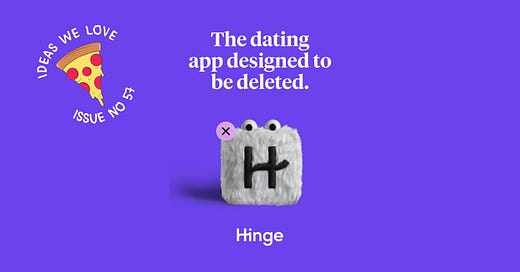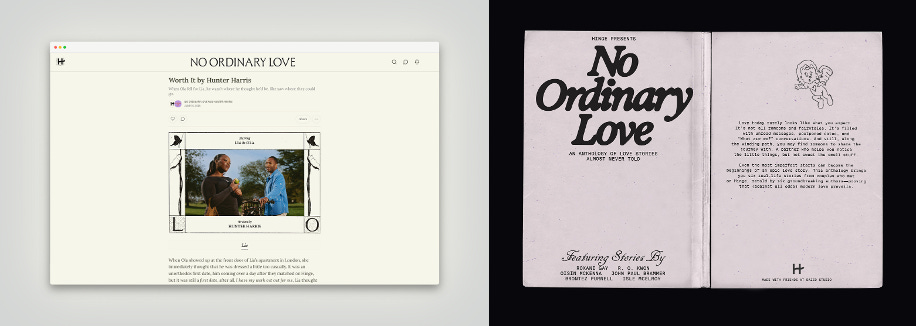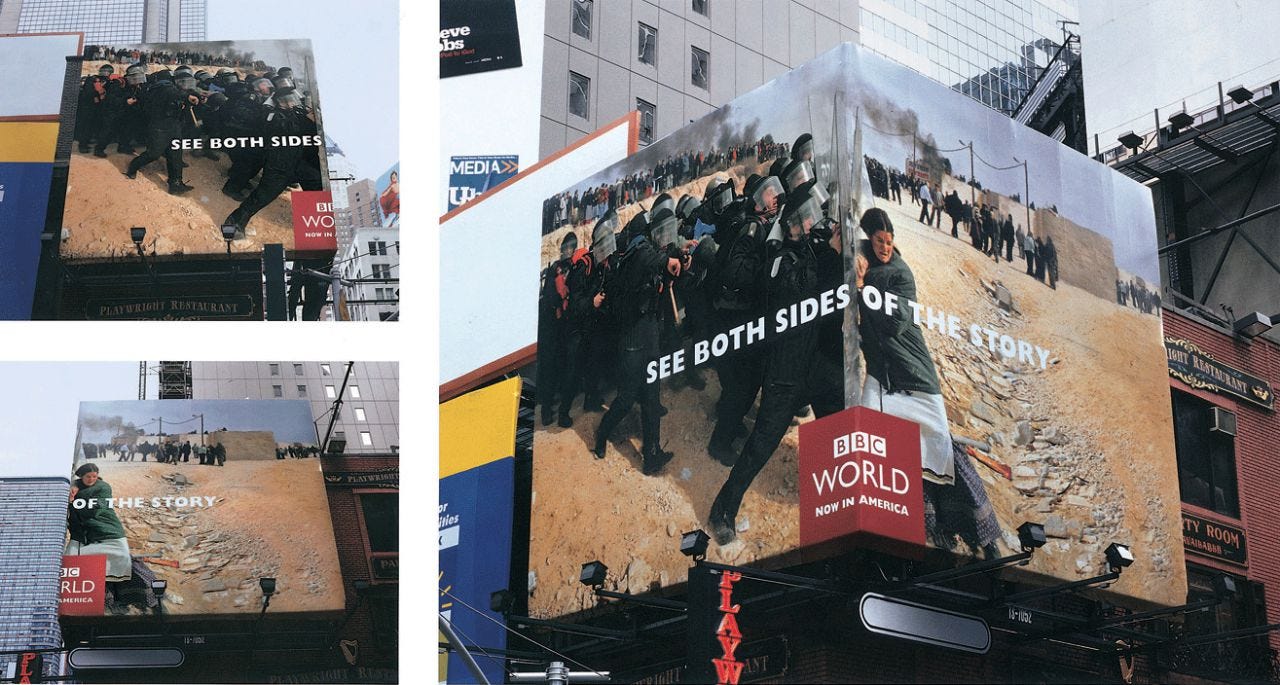Ideas We Love: Designed to be Deleted 👋
Issue Number 57: Hinge's creative platform has the ultimate KPI of "goodbye"
Hi there. How are you?
Everyone is down in Cannes this week for the annual Festival of Creativity, so it only makes sense that next week’s issue will be a roundup of some of the best ideas to come away with a Lion to their name. We continue to maintain that ‘metal’ is not acceptable to use as a verb (“we metalled in three categories”). This is a hill we are prepared to die on.
However we’re already seeing loads of great stuff get shortlisted or awarded, so it’s shaping up to be a cracker already….
In the meantime, something closer to home.
Walking through London over the last couple of weeks, we’ve noticed a new campaign from Dating service Hinge. A little bit of digging reveals that this is in fact the second iteration of a campaign entitled No Ordinary Love. The idea sees a number of figures from contemporary literature given the task of telling the stories of couples who have met on the platform. This year’s anthology places its emphasis on Gen-Z and LGBTQ stories, whereas last year’s set of stories sought to challenge the notion of ‘perfect fairtytale beginnings’ and railed against the tropes of romance literature - a genre that has refound popularity via #booktok.
Regular readers of IWL might recognise in No Ordinary Love the components which have drawn our attention. It’s a long idea with scope to run and run. It’s been pulled from paid for advertising down into Substack as a platform to deliver the contributing writer’s work as well as as a ‘physical’ zine published with Dazed. There is some smart uses of media formats in OOH, blending light-touch nudges with longer-form messaging in high dwell time environments on the tube. All very nice, huh?
The Idea: Designed to be Deleted ⬅️
Today though, we wanted to look at Designed to be Deleted. This is Hinge’s brand platform and the idea from which No Ordinary Love eminates from.
This is a classic example of challenger thinking - reframing a perceived business challenge (customer churn) into a mission statement for the brand. Not only that, but it implicitly calls out the competition for what might be perceived as predatory behaviour: the lonelier and more ‘single’ you are, the more dating services profit. The platform must resonate with consumers who are screen-fatigued. or concerned that long-term, some of our most vital relationships are being commodotised. According the Business of Apps, whilst Hinge lags behind market leader Tinder on global revenue, since launching Designed to Deleted, Hinge is growing revenue faster than the competition.
Theodore Levitt’s Marketing Myopia talks about companies finding ways to ‘plot the obscolesence of what produces your livelihood today’ and we think there are clearly echoes of that sentiment at work here, too.
What we’d do with it 💕
This is such a fertile platform. The act of deletion; either initiated by the user or the platform, or the comms that are being put out into the world by Hinge, offer loads of opportunities to stretch this idea into.
1. Dramatic Deletions 👋
The first thought we had was to make the act of deletion itself something that’s a little more interesting and a little more memorable.
Be that extending the ways people can delete the app from “in-app” to “in-public”; a little like this banger from back in the day…
…creating physical buttons or gestures that couples commit to together when the time is right with some unexpected drama along the way.
Or you might tie it into more aspirational endeavours; curating a range of experiences that are only available or accessible to couples who’ve deleted Hinge. Exclusive dates with a difference that mark the deletion of the app and your commitment to each other.
You’d make this happen by ensuring the booking URL is only accessible via the “farewell flow” in-app. Notifying people that their commitment has unlocked a table for two at the hot new chef’s table in Soho, tickets for the hottest gig at the O2, or something more weird and whacky and in-tune with their community as a thank-you from Hinge.
Then once you’ve got more people “deleting” the-app in symbolic ways, it makes sense to let others know about it right?
Leading to our next thought…
2. Departure Boards 🪧
Where you might secure tenancies on digital billboards, across prominent high-footfall OOH locations that act as live, real-time displays of couples leaving the app. Flipping the usual dating ad script from “potential matches” to “successful departures” from the dating game.
With each couple featured, the brand is delivering a little piece of social-proof that Hinge does exactly what it says on the tin. The more names that appear, the more the messaging lands…
This is a commitment the brand could lean into even further in “B2B” spaces too. They could make app deletions a feature of their earnings calls. Proudly chart app-deletions rather than app-installs as your measure of success, turning some of the tropes of big tech on their head - really leaning into the brand’s platform as it’s northstar.
Then, to ensure you’ve still got a business moving forwards as you’re losing so many couples from your subs-list, why not take the Designed to be Deleted blueprint and apply it to other parts of couple’s lives where the absence of the product is either proof that it worked, or where people would rather it didn’t exist.
3. Unleashing the Hinge Effect 🙌
Designed to be Deleted can become more than just a line. It could be repositioned as a license for Hinge to solve all sorts of problems that exist in consumer’s lives.
Having successfully paired a couple - Hinge could move into branded homeware: pots, pans, soft furnishing… all the stuff people typically buy when they move their relationship to the next stage and move in together.
In more adjacent categories - how might the brand think about solving other challenges in consumers lives where like Dating apps, a purchase is deemed to be a “necessary evil”. Insurance is where our heads went to in the first instance. Hinge could match couples with insurance services that are so-good, so seamless and intuitive that people simply forget about them unless they really need them.
Hinge could take this thought further and form a market place of likeminded brands - brands which acknowledge the uneasy alliance they have with their customers and are committed to playing their role and then gracefully exiting stage left.
If you like this, you’ll love… 💕
Some of the other things No Ordinary Love and Designed to be Deleted reminds us of….
#1. Blind Dates by The Guardian 📆
A long-running editorial feature in the Guardian’s Weekend Magazine. Two people meet for the first time and then give a blow by blow account of how the meeting went.
#2. Cornetto’s Love Stories
Matt worked on this back in day.
Working with the team at MullenLolaMadrid to create a two-sided love story where people could flip the perspective between the featured protagonists within the ad-format on YouTube in real-time.
With each “engagement” gaming the YouTube algorithm in ways that helped us reach significantly more people, with significantly more watch time per € than we otherwise would with a more conventional story-arc.
Like 10x more.
#3. See Both Sides of the Story by BBC World Service
From video to OOH, BBC’s Worldwide service used both sides of specific OOH locations to position their service as a trusted, impartial source of truth in a market where that objectivity is somewhat lacking.
Until Next Time… 💕
We’ll see you next time for our round up of the nicest ideas being awarded at the Cannes Festival of Advertising, Creativity and Rosé.
Cheerio. Tom & Matt x











This remains one of the best pieces of copywriting of the last decade